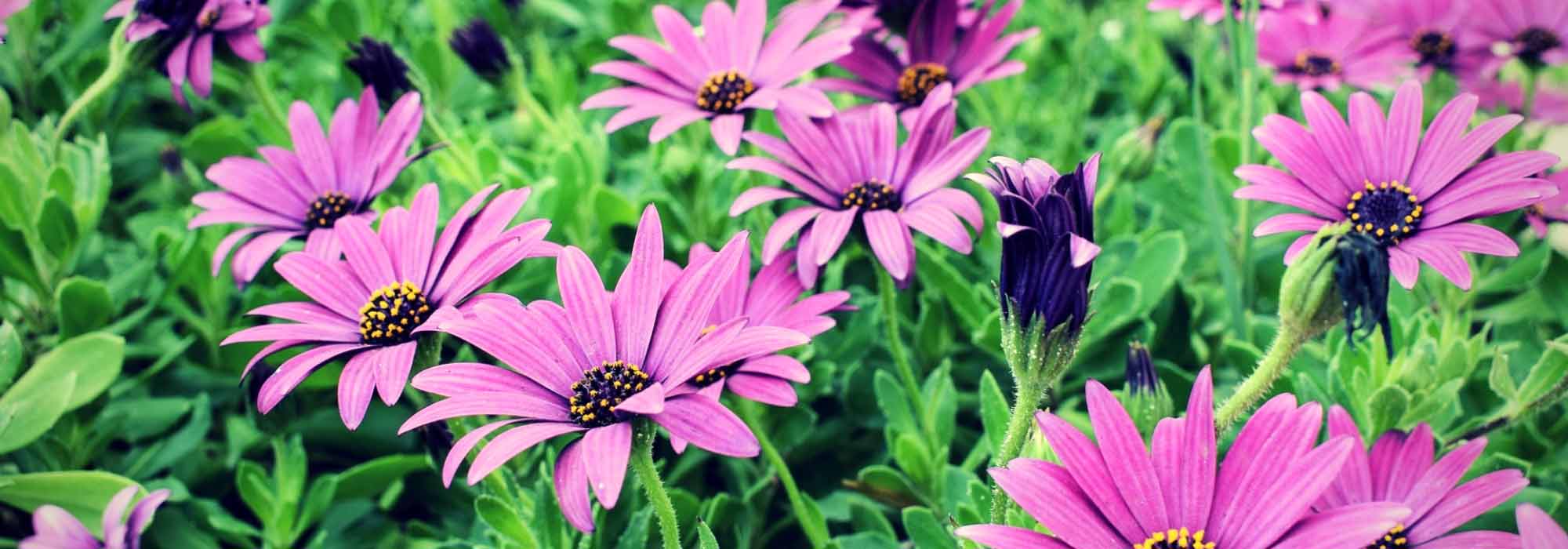
Osteospermum, African daisy: planting, pruning, care
Contents
Osteospermum in a nutshell
- Highly floriferous, Osteospermum offers a profusion of large daisies throughout autumn, characterised by simplicity and finesse, in shades of white, pink, mauve, or orange
- It possesses a charm that is both rustic and refined
- Frost-sensitive at -5°C, it is often grown as an annual plant in colder regions; elsewhere, it is perfectly perennial
- It requires little, thrives in sunlight, and enjoys light, well-drained soils
- Versatile and low in water requirements, it is a great choice for window boxes or pots on a balcony, as well as for borders, beds, or rockeries
A word from our expert
The Osteospermum, also known as Cape Daisy or African Daisy, is unmatched in brightening and adding colour to the garden with its large colourful heads in white, pink, mauve, yellow, or orange.
From the creeping Osteospermum that will not exceed 0.25 cm in height to Osteospermum ecklonis ‘Blue Streak’ with its metallic blue hues, through to the orange Osteospermum ‘Cape Daisy Fireburst’, all provide a colourful display from summer to autumn, whether in borders or pots.
Frost-sensitive at -5°C, it can only survive in the ground in very mild climates or by the sea, as it tolerates only light frosts. In colder regions, it is grown as an annual or as a pot plant overwintered in a frost-free environment.

Colour palette of Osteospermums: O. ‘Cape Daisy Purple’, O. ‘Summersmile Soft Violet’, O. ‘Margarita Creme’, O. ‘Summersmile Double Soft Yellow’, O. ‘Margarita Orange Flare’
Easy to grow and ideal for gardeners with limited time, Osteospermum is a less hardy perennial but is not afraid of drought or poor soils, requires little watering, and only demands full sun to thrive in well-drained soil.
How to grow an Osteospermum in a container, how to propagate Osteospermum by cuttings, or how to prune an Osteospermum, are just some of the questions we answer in this guide dedicated to this beautiful daisy that offers a sunny flowering beauty all summer long.
Description and Botany
Botanical data
- Latin name Osteospermum
- Family Asteraceae
- Common name Osteospermum, Cape Daisy, African Daisy, Rain Daisy
- Flowering from May to autumn
- Height 0.30 to 0.60 m
- Exposure Sun
- Soil type All, well-drained
- Hardiness -5°C, frost-prone
Belonging to the Asteraceae family, (formerly Compositae), like the daisy or Dimorphoteca with which it is often confused, the Osteospermum or Cape Daisy, African Daisy or Rain Daisy, is a perennial or annual plant, considered a shrub, primarily native to the meadows, steep slopes, and rocky mountains of South Africa.
While the genus comprises about 70 species, most Osteospermum cultivated in our gardens are hybrids between three species of uncertain origin, named directly by their cultivar name (Osteospermum ecklonis ‘Blue Streak’, Osteospermum ‘Voltage Yellow’, Osteospermum ‘Buttermilk’, O. Whirlygig…). They come in an impressive number of varieties.
Frost-prone at -5°C, it is often grown here as an annual, being cultivable as a perennial only in our coastal regions and mild winters.
With a vigorous growth habit, it develops on shallow rootstocks, a compact tuft with a ramified habit measuring 30 to 70 cm in height for nearly the same diameter, forming a true flowering cushion in just a few months. In mild climates, it will settle in and over time form dense and highly floriferous tufts that can spread up to 1 m in width.
The foliage, graphic, dense and well-maintained is evergreen in the favour of a mild winter. Emerging from a basal rosette, the short-stalked leaves are entire, obovate, dentate or lobed and sometimes slightly fleshy or villous. Measuring 4 to 10 cm long, they are bright green to grey-green and arranged alternately along the stems.
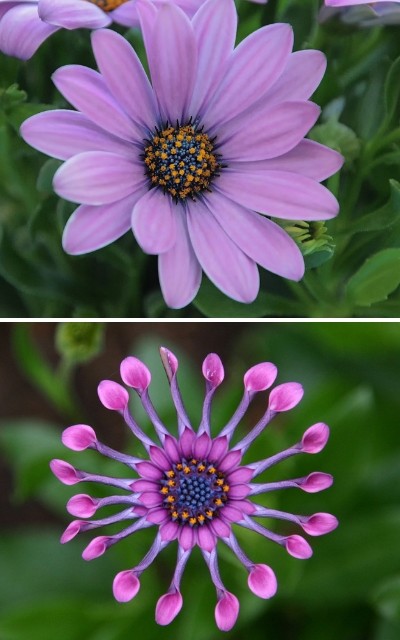
Two Osteospermums with different ligules
From these cushions of dissected leaves, whose interest lies mainly in their abundance, rise the slender yet robust floral stems measuring between 20 and 60 cm in height.
From May to October, continuously, it unfolds a profusion of solitary flowers or light panicles, resembling beautiful daisies. The flowers radiate in very bright heads with a velvety or satin texture, measuring 3 to 8 cm in diameter. The tightly arranged ray petals, highly dissected, spread around a golden, grey, or mauve-blue to metallic blue eye.
The shape and colour of the ligules vary according to the cultivars. While most have thin, flat ligules, some varieties are characterised by wavy and curiously spatulate petals ‘Whirligig’, or flowers with a double row of petals making them resemble large, tousled daisies: the Flower Power series comes in double varieties.
These candid flowers offer an infinite array of white, pink, mauve, purple, lavender blue, pale or golden yellow, red-bronze, brick (‘Terracotta’)… They are sometimes bicoloured with contrasting tips or the reverse of the petals or in delicate gradients.
They have the particularity of closing when the sun is obscured.
This flowering of extraordinary generosity and nectariferous quality attracts butterflies until the gates of winter.
Radiant and enduring, Osteospermum flowers have excellent vase life, making generous country bouquets.
The Osteospermum is a perennial grown as an annual in temperate climates that can be kept by bringing it under a veranda or a cold greenhouse in winter. Very little hardy, it fears frost from -5°C and can only survive the winter outdoors in mild climates and by the sea.
It is an undemanding plant that loves the aridity of well-drained, poor soils and full sun.
With its simple flowers, it allows for charming scenes in every corner of the garden, in sunny flowerbeds and borders. Low-maintenance, it is essential in natural gardens or gardens without gardeners, to which it always brings a subtle, cheerful, and colourful note.

Evolution of an Osteospermum flower
Read also
Planting annualsMain species and varieties
Our Osteospermum are available as plug plants that are easy to transplant or as seed packets to grow as annuals or perennials depending on your region. While the genus comprises around 70 species, we mainly find horticultural varieties resulting from various cross-breeding between wild species such as osteospermum ecklonis or osteospermum fruticosum. They come in dozens of varieties and cultivars, varying in height and colour, ranging from the more subdued to the most original.
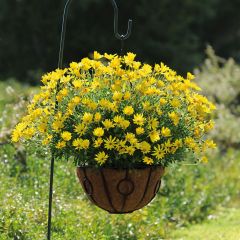
Osteospermum Voltage Yellow - Cape Daisy
- Flowering time July to November
- Height at maturity 30 cm
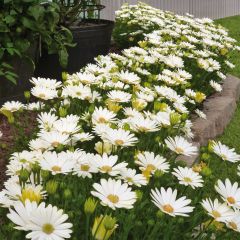
Osteospermum Summersmile Cream
- Flowering time July to November
- Height at maturity 30 cm
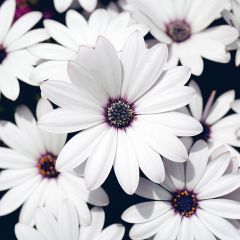
Osteospermum Cape Daisy White
- Flowering time June to November
- Height at maturity 40 cm
Osteospermum Cape Daisy Fireburst - Cape Daisy
- Flowering time June to October
- Height at maturity 30 cm
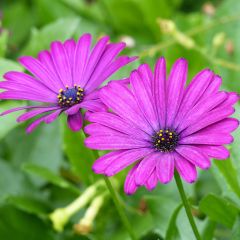
Osteospermum Tradewinds Trailing Deep Purple - Cape Daisy
- Flowering time May to October
- Height at maturity 30 cm
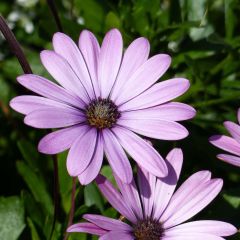
Osteospermum Summersmile Soft Violet - Cape Daisy
- Flowering time June to October
- Height at maturity 30 cm
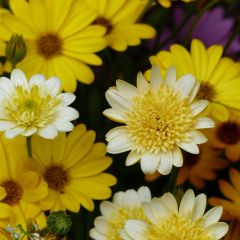
Osteospermum Summersmile Double Golden Yellow - Cape Daisy
- Flowering time June to October
- Height at maturity 30 cm

Osteospermum Passion Mixed - Cape Daisy
- Flowering time July to November
- Height at maturity 50 cm
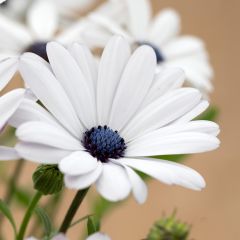
Osteospermum Glistening White - Cape Daisy
- Flowering time July to November
- Height at maturity 50 cm
Discover other Osteospermum
View all →Available in 1 sizes
Available in 2 sizes
Available in 1 sizes
Available in 2 sizes
Available in 1 sizes
Available in 1 sizes
Available in 1 sizes
Available in 1 sizes
Available in 1 sizes
Available in 1 sizes
Plantation
Where to Plant Osteospermum?
From its South African origins, this perennial has retained a great sensitivity to cold; very little hardy, the Osteospermum will only withstand light frosts (-5°C) and is most often grown as an annual in temperate climates. You can keep it in a pot by bringing it under a veranda or a cold greenhouse in winter to bring it back out in May for the beautiful season. However, in regions with mild winters or by the seaside, it can remain in the ground all year round.
This African daisy has also retained a preference for well-drained, poor, even sandy soils and requires full sun to bloom well and a sheltered position from cold winds. A soil that is too rich would encourage foliage growth at the expense of flowering.
Don’t be surprised, Osteospermum often takes a break in the middle of summer and sometimes goes into dormancy during hot and dry weather; it may then completely stop flowering, so it is wise to combine it with other flowers.
With its simple, candid flowers, it allows for the quick creation of charming and bucolic scenes in every corner of the garden, in cottage-style beds, as ground cover in sunny borders or rockeries. It adds lightness to compositions.
It even finds its place in cottage-style pots on a terrace or balcony in full south-facing sun.
When to Plant Osteospermum?
Planting of Osteospermum is done in spring, in April-May (from March in mild regions) outside of frost periods.
How to Plant Osteospermum?
In the Ground
To bloom well, Osteospermum prefers a light soil: improve drainage in heavy soils with a few shovelfuls of river sand. Plan for 5 to 7 plug plants per m² depending on the desired effect and plant them in a staggered pattern, spaced at least 25 cm apart in all directions: our Osteospermum will quickly make a big impact. Plant it outside of frost periods from March to June depending on the regions.
- Dig a hole two to three times wider than the root ball
- At the bottom of the hole, spread a draining layer of gravel or clay pebbles
- Do not bury the plug plant too deeply
- Backfill with planting soil
- Lightly firm down and water abundantly after planting
Growing an Osteospermum in a Pot
Osteospermum will appreciate a moderately rich substrate: mix potting soil for geraniums with some garden soil and sand in equal parts. Plan for 2 or 3 plug plants for a large pot, one for a pot with a diameter of 25 cm.
- Spread a good draining layer at the bottom of the pot
- Plant in the soil-potting mix combined with a bit of river sand
- Water regularly during the warm season
→ Learn more about growing Osteospermum in a pot in our advice sheet!
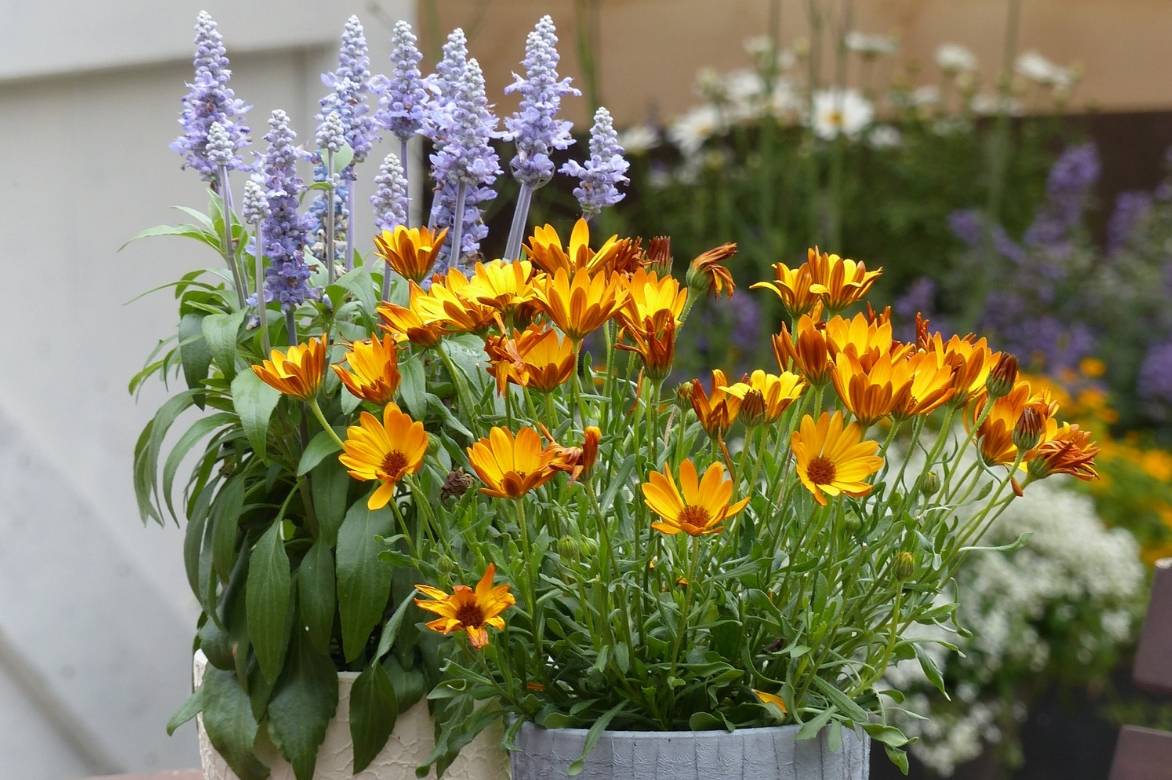
Osteospermum is well-suited for pot cultivation
When and how to sow Osteospermum seeds?
Sowing takes place from March to April in a good seed compost.
- Sow the Osteospermum seeds in trays or pots filled with compost
- Cover the seeds with a thin layer of compost (3 mm) and lightly firm down
- Keep the substrate just moist until germination (10-15 days) at a temperature of 15-18°C
- Thin out the seedlings, then after 3 weeks, transplant the young shoots into individual pots
- When the seedlings have hardened off well, transplant them into larger pots
- Once all risk of frost has passed, transplant the young plants into the garden
Maintenance, pruning and care of Osteospermum
The Osteospermum requires little maintenance. Particularly drought-resistant, it needs little watering: water only when the heat persists and when the flower stems begin to droop.
Potted Osteospermum dry out more quickly: provide more regular watering.
In all cases, water without wetting the leaves. Mulch with dry mulch (flax shavings, clippings) to limit water needs.
During prolonged dry periods, it may stop flowering and enter dormancy: continue watering, it will start blooming again in September.
Along the coast and in regions with mild winters, these large daisies are perfectly perennial and can remain in the ground: cut back the clump in autumn and protect it from the cold with a good layer of fallen leaves.
In cold climates where it is grown as an annual flower, it will be uprooted at the end of summer or overwintered to protect it from frost.
Throughout the growth period and to support the flowering of potted osteospermum, which are always a bit more demanding, apply a liquid organic fertiliser for geraniums once or twice a month.
If you want to keep this tender perennial; store the pots in a bright conservatory or a lightly heated greenhouse at the first frosts. You can bring them out in spring, in May, as soon as temperatures have warmed up.
Keep the substrate almost dry in winter and stop fertilising.
When and how to prune an Osteospermum
- To ensure your Osteospermum plants are well-branched, pinch (pinch the tips with your fingers) the overly long stems in spring to encourage branching
- Dare to remove the first flowers: the plant will produce an even more generous flowering.
- Regularly remove faded flowers to allow young buds to develop
- Cut back the clump in autumn before storing the pots away from frost
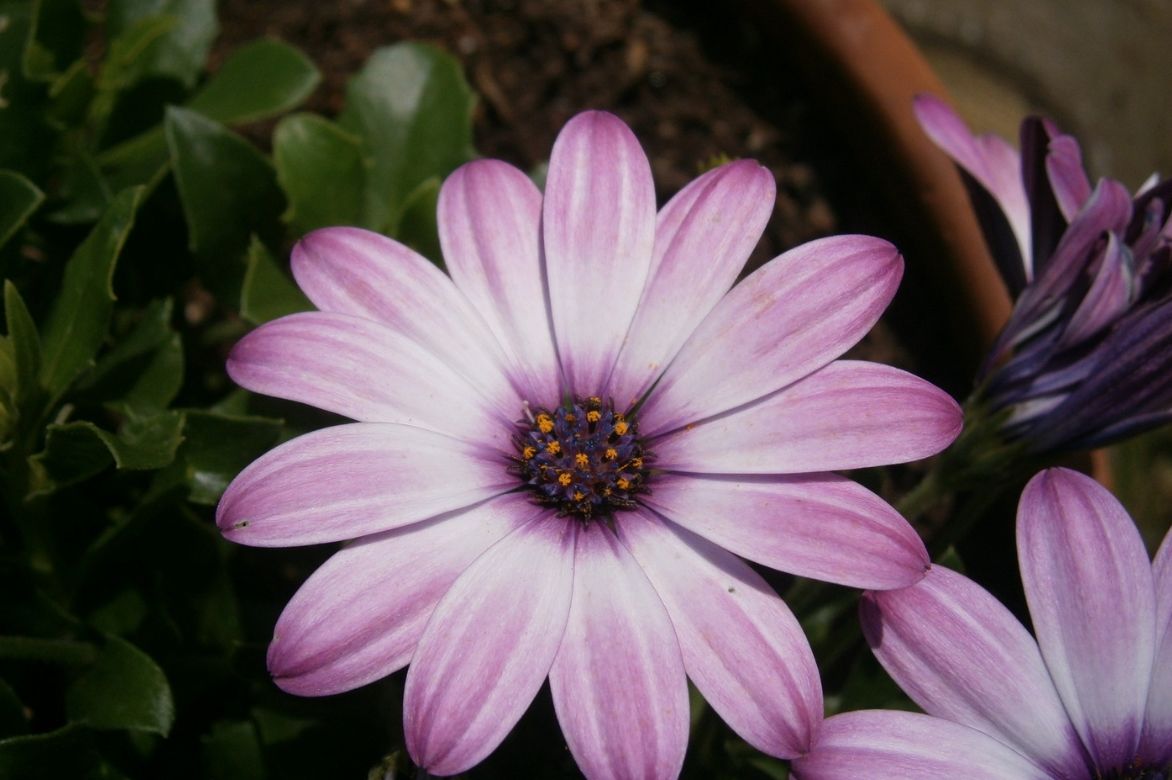
Diseases and potential pests
Rather vigorous, the osteospermum is rarely diseased. However, it can be infested with aphids: spray with water mixed with black soap.
The plant can sometimes be prone to powdery mildew or downy mildew, which are characterised by white fluff and leaf spots on the foliage. As a preventive measure: when planting, space your plants sufficiently, water at the base without wetting the leaves, and spray with horsetail decoctions or nettle manure. In case of infection: immediately remove the affected parts or plants and burn them.
Propagation by cuttings of Osteospermum
If sowing is possible with seeds harvested in autumn from your garden, the seedlings resulting from these seeds will not carry the character of the mother plant. For plants that conform in colour, we recommend propagation by cuttings of the Osteospermum in spring or summer, which is simpler and less uncertain. It allows you to easily renew your plants from one year to the next.
- In summer, cut 15 cm sections of stems without flowers
- Remove the lateral flower buds as well as the lower leaves from the stems
- Plant the cuttings in pots of turf and sand
- Place the cuttings in a humid environment and protect them from frost by covering them with a lid or transparent plastic
- Transplant in the following spring when they are sufficiently rooted
→ Learn more about propagation by cuttings of Osteospermum in our tutorial!
Associating
With its bushy silhouette and large, simple flowers in shades of pink, mauve, purple, white, soft yellow, or bright orange, Osteospermum thrives in gardens of all styles, bringing colour and cheerfulness.
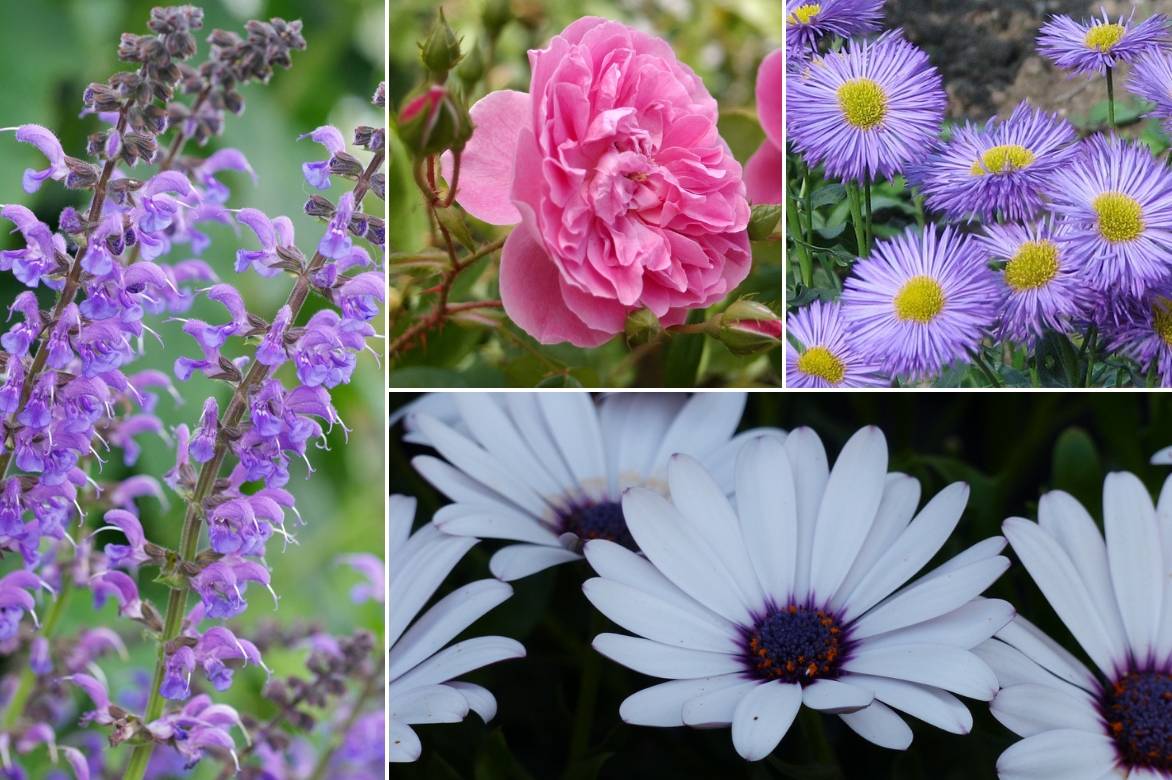
An example of a country-style pairing: Osteospermum ‘Cape Daisy White’, Salvia sylvestris ‘Rhapsody in Blue’, Erigeron speciosus ‘Grandiflorus’, and Rose ‘Harlow Carr’
It sweeps across a wide palette of colours and fits seamlessly into any setting. It is particularly suited to poetic and charming atmospheres or for creating scenes with a wild, fresh, or vibrant appearance, brightening a lush mixed border or a summer pot.
Its pastel or vivid hues and upright habit make it a valuable plant in combinations with other annuals and summer-flowering perennials.
In a large bed scorched by the summer sun, plant it in the midst of a bed of nemesia, nigella, knautia, and petunias bordered by brachycome; you will enjoy a profusion of flowers for at least three months with no maintenance required!
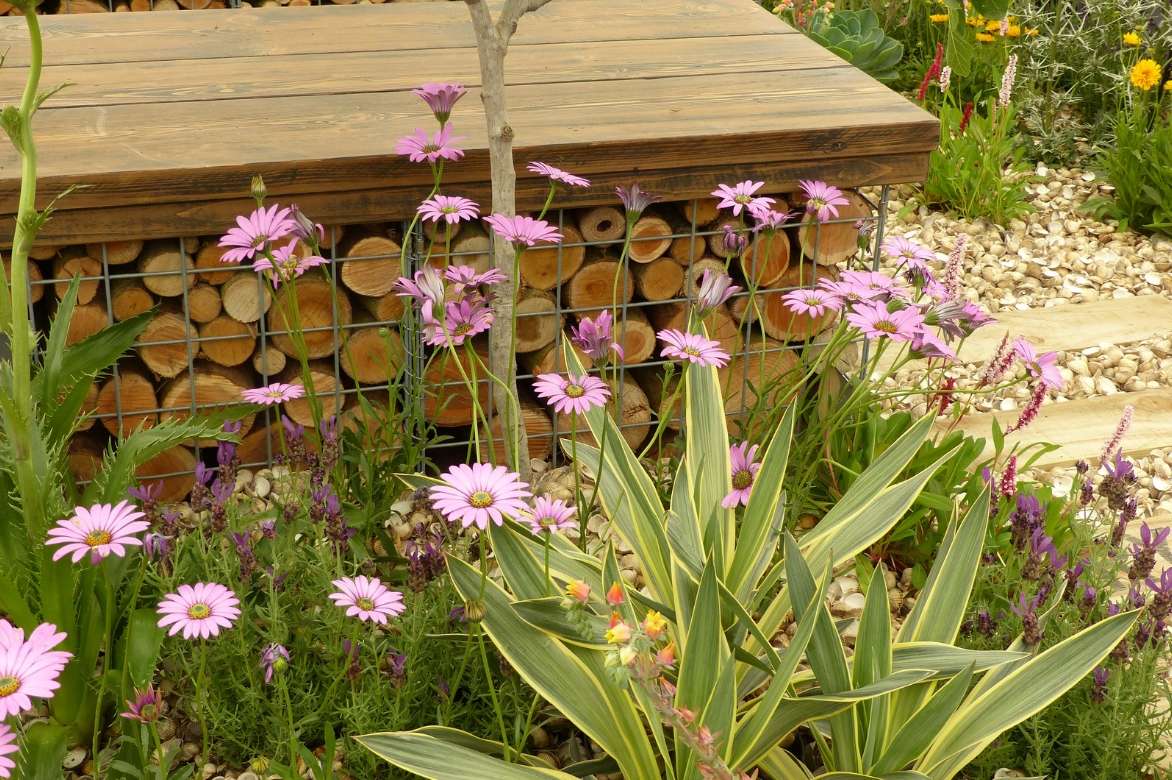
A lovely exotic scene: Osteospermum jucundum and Yucca gloriosa ‘Variegata’
For a very fresh tableau in a pastel colour scheme, mix the large heads of ornamental Allium, gaura, Erigeron karvinskianus, or Agapanthus that will rise majestically above the flattened clumps of Osteospermum.
In a sunny, well-drained rockery, it will be the perfect companion to other low plants such as salvia and veronica, lantanas, and with succulent plants like sedums.
Next to grasses, it structures and colours the summer. The flowering of Asters and everlasting flowers will accompany it into autumn.
In large pots, it will neighbour with bidens, a scented geranium, or begonias.
→ Discover more pairing ideas with osteospermum in our advice sheet!
Useful resources
- Discover which annual plants to pair with Osteospermum?
- Incorporate Osteospermum into a naturalistic garden
- With their charming daisy-like appearance, Osteospermum are essential in romantic gardens
- Discover our 7 pairing ideas to create beautiful summer planters
- Subscribe!
- Contents
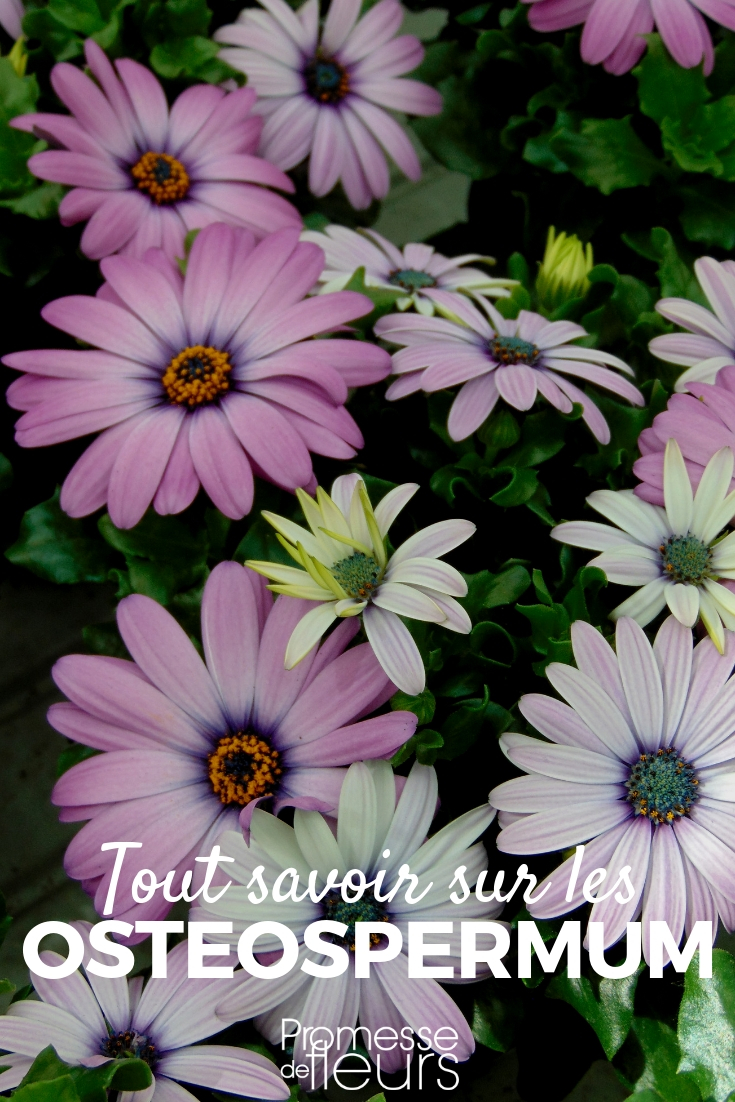































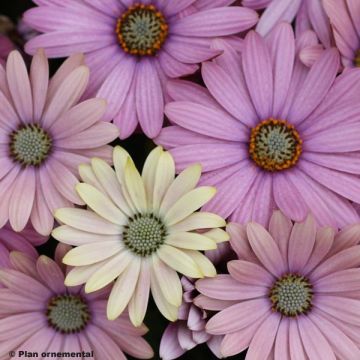




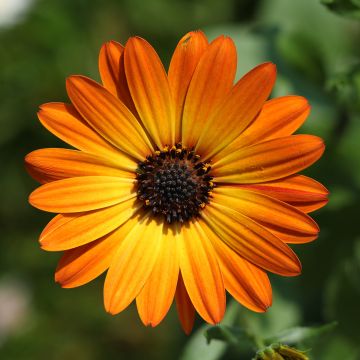
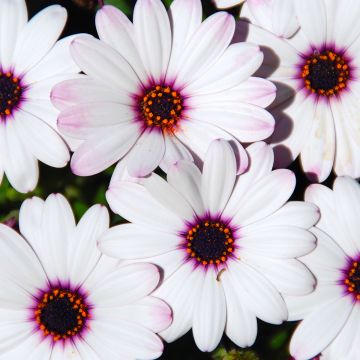
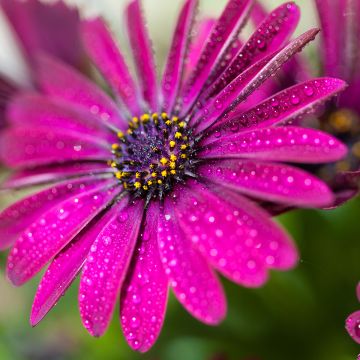
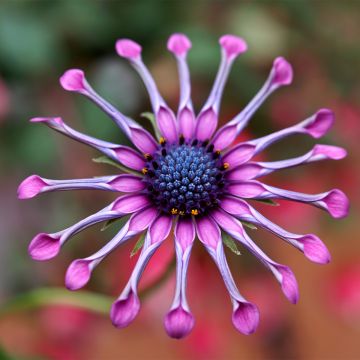
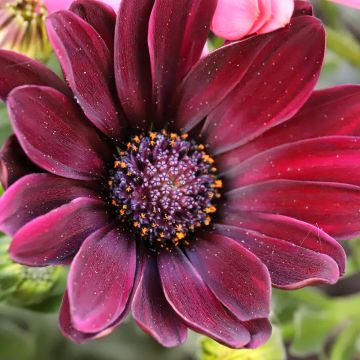
Comments